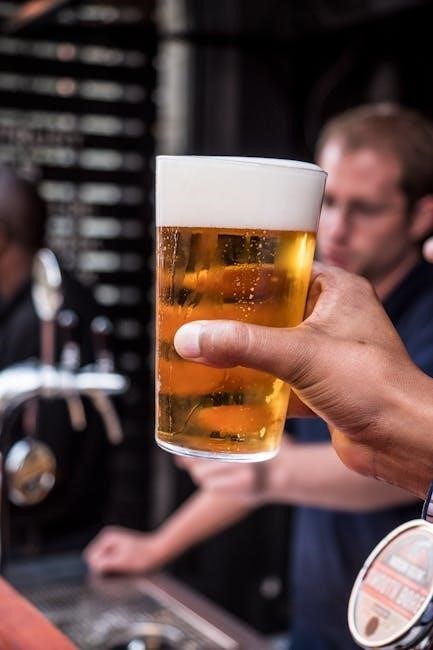Beer is an ancient, versatile alcoholic beverage made from fermented grains like barley, hops, yeast, and water, enjoyed globally for its rich flavors and cultural significance.
1.1. What is Beer?
Beer is an alcoholic beverage produced through the fermentation of starches from cereal grains, primarily malted barley, though wheat, maize, rice, and oats are also used. It is made by extracting these grains with water, boiling the mixture with hops for flavor and preservation, and fermenting the result with yeast. Beer’s alcohol content typically ranges from 4% to 12%, depending on the style. It is one of the oldest and most widely consumed beverages worldwide, offering a diverse range of flavors and styles that cater to various tastes and cultural preferences. Its simplicity in ingredients yet complexity in execution makes it a beloved drink globally.
1.2. Brief History of Beer
Beer’s origins trace back thousands of years to ancient civilizations in Mesopotamia, Egypt, and China, where it was first brewed around 6000 BCE. Early beer was made from fermented barley and emmer wheat, often flavored with herbs and spices. The process spread globally, with each culture adapting techniques and ingredients to create unique styles. The Egyptians documented brewing methods on papyrus, while the Babylonians praised beer as a gift from the gods. By the Middle Ages, monasteries in Europe became key brewers, refining practices that laid the foundation for modern brewing. Beer’s rich history reflects its enduring role in society, culture, and trade.
1.3. Cultural Significance of Beer
Beer holds a profound cultural significance worldwide, often serving as a unifying element in social gatherings, celebrations, and traditions. From ancient rituals to modern festivals like Oktoberfest, beer has played a central role in many societies. In numerous cultures, pubs and breweries act as community hubs, fostering connections and camaraderie. Beer’s influence extends to art, literature, and cuisine, reflecting its deep-rooted presence in human history. Its versatility and variety have made it a cherished beverage, symbolizing joy, togetherness, and cultural identity across generations and geographies.

Beer Styles
Beer styles offer incredible diversity, ranging from crisp lagers to hoppy IPAs, rich stouts, and tangy sours, each showcasing unique flavor profiles shaped by ingredients and brewing methods.
2.1. Popular Beer Types: IPA, Lager, Pale Ale, Stout, and Sour
IPAs are hop-forward, offering bold bitterness and fruity aromas, while lagers are crisp and refreshing with smooth, clean finishes. Pale ales strike a balance between malt and hops, providing approachable flavors. Stouts are dark, robust beers with roasted notes, often featuring coffee or chocolate undertones. Sours, meanwhile, showcase tangy, tart profiles, sometimes infused with fruits for added complexity. Each style highlights unique brewing techniques and flavor profiles, catering to a wide range of palates and preferences among beer enthusiasts.
2.2. Characteristics of Ales and Lagers
Ales and lagers differ primarily in fermentation methods. Ales use top-fermenting yeast, producing fruity, estery flavors and robust, complex profiles, often with cloudy appearances. They ferment at warmer temperatures, yielding quicker results. Lagers, using bottom-fermenting yeast, are fermented at cooler temperatures, resulting in clean, smooth, and crisp flavors with clear appearances. Lagers require cold storage for extended periods, enhancing their mellow character. These distinctions define their unique taste profiles, catering to varied preferences among beer enthusiasts.
2.3. Specialty Beers: Barley Wine, Porter, and More
Specialty beers like barley wine and porter offer unique flavors and complexities. Barley wine, with alcohol content similar to wine, features rich, malty, and often fruity notes. Porter, known for its dark color, showcases chocolate and caramel flavors; Other styles, such as Gose and Lambic, incorporate wild yeast or fruits for tart, refreshing profiles. These beers often blend traditional brewing methods with creative ingredients, making them standout choices for adventurous drinkers. Their distinct characteristics and intricate flavor profiles set them apart in the world of craft beer.

The Brewing Process
Beer is crafted by extracting raw materials with water, boiling with hops, and fermenting with yeast, transforming simple ingredients into a diverse, flavorful alcoholic beverage.
3.1. Ingredients: Malted Grains, Hops, Yeast, and Water
Beer is crafted from four primary ingredients: malted grains, hops, yeast, and water. Malted grains, typically barley, provide fermentable sugars and flavor. Hops add bitterness, aroma, and preservative qualities. Yeast ferments sugars into alcohol, determining the beer’s character. Water, the base, influences the final profile. These elements combine to create the diverse flavors and styles of beer, each contributing uniquely to the brewing process.
3.2. Steps in Beer Production: Fermentation, Boiling, and Aging
Beer production involves key steps: boiling, fermentation, and aging. Boiling extracts hop flavors and sterilizes the mixture. Fermentation, driven by yeast, converts sugars into alcohol, lasting 7-14 days. Aging refines flavors, with time varying by style. These steps ensure a balanced, flavorful final product.

Beer and Food Pairing
Beer and food pairing enhances dining experiences by matching flavors. IPAs complement spicy dishes, while stouts pair well with desserts, offering endless combinations for culinary exploration.
4.1. Matching Beer Styles to Food
Matching beer styles to food enhances flavor profiles and dining experiences. IPAs pair well with spicy dishes, while lagers complement lighter fare like salads or seafood. Stouts are ideal for rich desserts, and sour beers cut through fatty meats. Pale ales work beautifully with roasted vegetables, and wheat beers refresh tropical or citrus-based dishes. Understanding the balance of malt, hops, and yeast in beer helps align it with complementary food flavors, creating harmonious and enjoyable pairings for any meal.
4.2. Ideal Pairings for Common Beer Types
IPA pairs perfectly with spicy dishes or robust cheeses, while lager complements lighter fare like seafood or salads. Stout is a great match for chocolate desserts or coffee-flavored treats. Sour beers excel with fatty meats or tangy dishes, cutting through richness. Pale ales work well with grilled meats or roasted vegetables, and wheat beers are ideal for tropical or citrus-based dishes. Porter is excellent with smoky barbecue or caramelized onions, while barley wine pairs beautifully with aged cheeses or dried fruits. Each beer style offers unique pairing opportunities to elevate your dining experience.

Beer Appreciation
Beer appreciation involves savoring its aroma, flavor, and appearance, enhanced by proper glassware. Experts like Annabel Smith emphasize the importance of tasting techniques to fully enjoy its complexity.
5;1. How to Taste Beer: Appearance, Aroma, and Flavor
Tasting beer involves assessing its appearance, aroma, and flavor. Start by observing the beer’s color and clarity. Next, swirl the glass to release the aroma, noting scents like malt, hops, or fruit. Finally, sip to experience the flavor profile, which may range from sweet to bitter. Proper glassware enhances these elements, allowing a deeper appreciation of the brew’s complexity and craftsmanship.
5.2. The Importance of Beer Glasses
The shape and size of beer glasses significantly impact the tasting experience. Different styles enhance aroma, flavor, and appearance, ensuring optimal enjoyment. For example, pilsners are best in tall, narrow glasses to preserve clarity and head, while stouts benefit from tulip-shaped glasses to highlight roasted notes. Using the right glassware amplifies the beer’s unique characteristics, allowing drinkers to fully appreciate its craftsmanship. Whether a casual sipper or a dedicated enthusiast, proper glassware elevates the experience, making it an essential tool for beer appreciation.
Resources for Beer Enthusiasts
Explore apps like The Good Beer Guide and CraftBeer.com’s study guide for detailed beer styles. Books like “The Beer Brewing Guide” offer insights into brewing and tasting.
6.1. Beer Guides and Apps
Discover top beer guides and apps like The Good Beer Guide and CraftBeer.com’s Beer Styles Study Guide. These tools offer detailed pub listings, brewery information, and beer descriptions. Apps provide interactive features to explore beer styles, pairing suggestions, and brewery maps. Websites like BeerAdvocate and Untappd allow users to rate and review beers, while platforms like Beer Guide apps help navigate local beer scenes. Additionally, resources like the BJCP Study Guide aid enthusiasts in understanding beer judging criteria. These guides and apps are essential for both newcomers and seasoned beer lovers to enhance their knowledge and enjoyment of craft beer.
6.2. Recommended Books for Beer Lovers
For deeper insights, explore books like The Good Beer Guide by Annabel Smith, offering expert knowledge on pubs and breweries. Beer: The Ultimate World Tour by Tim Hampson is another must-read, covering global beer styles and cultures. The Beer Bible by Jeff Alworth provides an exhaustive guide to beer history, styles, and tasting notes. These books are perfect for enthusiasts seeking to broaden their understanding and appreciation of beer, whether you’re a novice or a connoisseur. They offer comprehensive insights into the world of brewing and its rich traditions.

